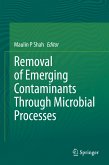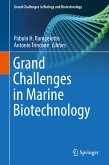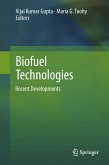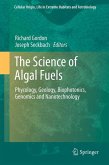Prospects and Challenges in Algal Biotechnology (eBook, PDF)
Redaktion: Tripathi, Bhumi Nath; Kumar, Dhananjay
112,95 €
112,95 €
inkl. MwSt.
Sofort per Download lieferbar

56 °P sammeln
112,95 €
Als Download kaufen

112,95 €
inkl. MwSt.
Sofort per Download lieferbar

56 °P sammeln
Jetzt verschenken
Alle Infos zum eBook verschenken
112,95 €
inkl. MwSt.
Sofort per Download lieferbar
Alle Infos zum eBook verschenken

56 °P sammeln
Prospects and Challenges in Algal Biotechnology (eBook, PDF)
Redaktion: Tripathi, Bhumi Nath; Kumar, Dhananjay
- Format: PDF
- Merkliste
- Auf die Merkliste
- Bewerten Bewerten
- Teilen
- Produkt teilen
- Produkterinnerung
- Produkterinnerung

Bitte loggen Sie sich zunächst in Ihr Kundenkonto ein oder registrieren Sie sich bei
bücher.de, um das eBook-Abo tolino select nutzen zu können.
Hier können Sie sich einloggen
Hier können Sie sich einloggen
Sie sind bereits eingeloggt. Klicken Sie auf 2. tolino select Abo, um fortzufahren.

Bitte loggen Sie sich zunächst in Ihr Kundenkonto ein oder registrieren Sie sich bei bücher.de, um das eBook-Abo tolino select nutzen zu können.
Provides an overview of the numerous industrial applications of microalgae
Furthers readers' understanding of the biotechnological potential microalgae offer
Discusses critically topics such as algae-based biofuels and CO2 sequestration
- Geräte: PC
- ohne Kopierschutz
- eBook Hilfe
- Größe: 13.01MB
Andere Kunden interessierten sich auch für
![Microbiology for Cleaner Production and Environmental Sustainability (eBook, PDF) Microbiology for Cleaner Production and Environmental Sustainability (eBook, PDF)]() Microbiology for Cleaner Production and Environmental Sustainability (eBook, PDF)83,95 €
Microbiology for Cleaner Production and Environmental Sustainability (eBook, PDF)83,95 €![Removal of Emerging Contaminants Through Microbial Processes (eBook, PDF) Removal of Emerging Contaminants Through Microbial Processes (eBook, PDF)]() Removal of Emerging Contaminants Through Microbial Processes (eBook, PDF)175,95 €
Removal of Emerging Contaminants Through Microbial Processes (eBook, PDF)175,95 €![Grand Challenges in Marine Biotechnology (eBook, PDF) Grand Challenges in Marine Biotechnology (eBook, PDF)]() Grand Challenges in Marine Biotechnology (eBook, PDF)112,95 €
Grand Challenges in Marine Biotechnology (eBook, PDF)112,95 €![Biofuel Technologies (eBook, PDF) Biofuel Technologies (eBook, PDF)]() Biofuel Technologies (eBook, PDF)160,95 €
Biofuel Technologies (eBook, PDF)160,95 €![The Science of Algal Fuels (eBook, PDF) The Science of Algal Fuels (eBook, PDF)]() The Science of Algal Fuels (eBook, PDF)112,95 €
The Science of Algal Fuels (eBook, PDF)112,95 €![Microbiological Aspects of Biofilms and Drinking Water (eBook, PDF) Microbiological Aspects of Biofilms and Drinking Water (eBook, PDF)]() Steven Lane PercivalMicrobiological Aspects of Biofilms and Drinking Water (eBook, PDF)48,95 €
Steven Lane PercivalMicrobiological Aspects of Biofilms and Drinking Water (eBook, PDF)48,95 €![Biofilm Highlights (eBook, PDF) Biofilm Highlights (eBook, PDF)]() Biofilm Highlights (eBook, PDF)175,95 €
Biofilm Highlights (eBook, PDF)175,95 €-
-
-
Provides an overview of the numerous industrial applications of microalgae
Furthers readers' understanding of the biotechnological potential microalgae offer
Discusses critically topics such as algae-based biofuels and CO2 sequestration
Furthers readers' understanding of the biotechnological potential microalgae offer
Discusses critically topics such as algae-based biofuels and CO2 sequestration
Dieser Download kann aus rechtlichen Gründen nur mit Rechnungsadresse in A, B, BG, CY, CZ, D, DK, EW, E, FIN, F, GR, HR, H, IRL, I, LT, L, LR, M, NL, PL, P, R, S, SLO, SK ausgeliefert werden.
Produktdetails
- Produktdetails
- Verlag: Springer Nature Singapore
- Seitenzahl: 326
- Erscheinungstermin: 8. November 2017
- Englisch
- ISBN-13: 9789811019500
- Artikelnr.: 53034730
- Verlag: Springer Nature Singapore
- Seitenzahl: 326
- Erscheinungstermin: 8. November 2017
- Englisch
- ISBN-13: 9789811019500
- Artikelnr.: 53034730
- Herstellerkennzeichnung Die Herstellerinformationen sind derzeit nicht verfügbar.
Dr. Bhumi Nath Tripathi obtained his PhD from Banaras Hindu University, India. Currently, he is working at Department of Biotechnology, Indira Gandhi National Tribal University, Amarkantak, India. He has long lasting work experience on Stress Physiology of plants and Algal Biology. He recipient of several fellowships and research grants. He has published more than 50 research papers in journals of international repute. He has also published three books on Stress responses in Plants, Molecular Biology and Biotechnology and Applications of Biotechnology. Dr. Dhananjay Kumar has obtained his PhD from Banaras Hindu University. Currently, he is working at Department of Botany, H.N.B Garhwal University. His research work is focused on Algal Biology especially use of algae/algal mat for the removal of metal contaminants. He is also recipient of DS Kothari Post-Doctoral Fellowship and worked at Jawaharlal Nehru University. He has published several research papers in journals of international repute.
Section I:Algal Culture Technology.- 1.General Introduction.- 2.The culture technology for freshwater microalgae and cyanobacteria.- 3.The culture technology for marine algae and cyanobacteria.- 4.The culture technology for Periphytons and Cyanobacterial mats.- 5.The culture technology for extremophilic algae including cyanobacteria.- Section II Algal Biofuel and CO2 sequestration.- 6.Suitability of algae for biofuel production.- 7.Generation and harvesting of algal biomass for biofuel production.- 8.Manipulation of algal lipid production.- 9.System biology approach to enhance algal lipid production.- 10.Algae and carbon sequestration: Role, strategy and future perspectives.- Section III Algae in wastewater treatment.- 11.Planktonic algae and wastewater treatment: advantages and disadvantages.- 12.Wastewater treatment using Phototrophic biofilms and cyanobacterial mats.- 13.Algal turf scruber technology and periphytons.- 14.Biosrption heavy metals and dyes from industrial effluents.- Section IV Bioactive and High Value Chemical Compounds.- 15.Algae as source of pharmaceuticals.- 16.Algae as sources of food and nutraceuticals.- 17. Metabolic engineering for the production of high value algal products.
Section I:Algal Culture Technology.- 1.General Introduction.- 2.The culture technology for freshwater microalgae and cyanobacteria.- 3.The culture technology for marine algae and cyanobacteria.- 4.The culture technology for Periphytons and Cyanobacterial mats.- 5.The culture technology for extremophilic algae including cyanobacteria.- Section II Algal Biofuel and CO2 sequestration.- 6.Suitability of algae for biofuel production.- 7.Generation and harvesting of algal biomass for biofuel production.- 8.Manipulation of algal lipid production.- 9.System biology approach to enhance algal lipid production.- 10.Algae and carbon sequestration: Role, strategy and future perspectives.- Section III Algae in wastewater treatment.- 11.Planktonic algae and wastewater treatment: advantages and disadvantages.- 12.Wastewater treatment using Phototrophic biofilms and cyanobacterial mats.- 13.Algal turf scruber technology and periphytons.- 14.Biosrption heavy metals and dyes from industrial effluents.- Section IV Bioactive and High Value Chemical Compounds.- 15.Algae as source of pharmaceuticals.- 16.Algae as sources of food and nutraceuticals.- 17. Metabolic engineering for the production of high value algal products.







